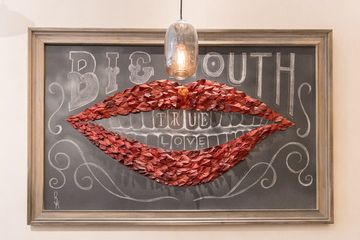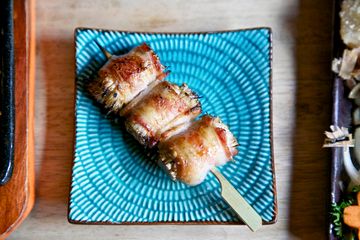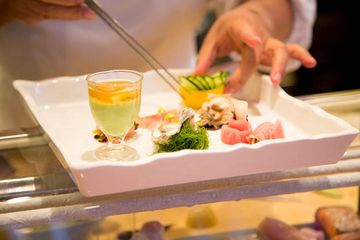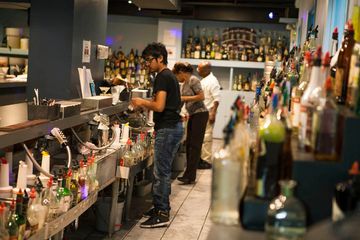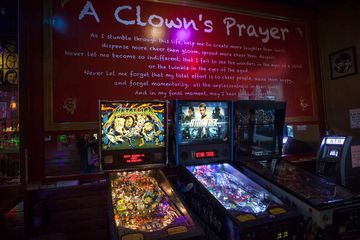Today, NoMad – short for North of Madison Square Park – is one of Manhattan’s hottest neighborhoods, but Moku, co-owner of Izakaya NoMad, could not have foreseen that when location-scouting for his New York variation of a classic Japanese izakaya (a casual bar serving small plates that pair well with alcohol). Having owned an izakaya in Korea Town, Moku wanted to bring Japanese food to a region where it was sparse. Averi, a member of the Manhattan Sideways team, had an exceptional experience at Izakaya NoMad. Upon her arrival, she was greeted warmly by Moku and his team and quickly shown around the restaurant before the dinner crowd poured in. They started at the front of the house, where Moku pointed out the first section of a three-part custom mural painted by an illustrator from the School for Visual Arts, depicting NoMad infused with elements of Japanese pop culture like Godzilla and Astro Boy. From there, they moved into a long, narrow hall lined with cozy geometric booths, a long bar and open kitchen. Moku admitted that it would have been easier to have the kitchen stationed in the rear like most eateries, but he and co-founder Jay desired to be transparent about their high quality ingredients and also wanted guests to be able to interact with their culinarily well-versed yakitori chef (who coincidentally, bares the nickname Godzilla). Passing by the bar, Averi and her hosts drifted to the back of the dining room, where on an elevated platform, reconfigurable chairs rested under cubed light fixtures. Behind them, modern counters hid in an exposed brick cove with a graffiti reptilian tail tagged on the wall. Back at the front, Averi took a seat at a grand communal table wrapped in cool light from the descending sun and decorative paper lanterns overhead. Sliding doors reminiscent of shōji separate the area from the restaurant upon request, creating an ideal space for company dinners and birthday parties. Moku noted that Izakaya Nomad's design established five “unique spaces… like a maze. ” The bar was intimate and mature, the tables on the platform familial and familiar, the urban grotto youthful and hip, and the front room airy and conversation invoking. Once settled, Moku shared the novel-like menu with Averi, consisting of yakitori, sashimi, sushi, tataki, tempura, hot pots, wine, beer, and sake with informative descriptions for those who may be unfamiliar with Japanese cuisine. A waiter then brought three varieties of sake, and Moku gave Averi a brief lesson in the fermented rice alcohol. She learned that the intensity of flavor stems from how much the outer layer of each grain of rice is stripped away. For example, the harder junmai sake polishes less of the grain – only about thirty percent - so it had a strong rice taste, which Moku claims is popular with young people these days. The junmai ginjo sake takes away about forty percent of the grain, resulting in a subtle sweetness, while the junmai daiginjo removes fifty percent, leaving a “smooth” creamy texture and “less hangover. ” The junmai daiginjo was Averi's favorite of the three, crisp and refreshing with just enough punch. Moku assured her that if sake is not a guest’s "cup of tea, " an impressive list of both beer and wine are available. After drinks, Moku reviewed the custom tasting menu that had been prepared for Averi's visit. With lobster tail, soft fried tofu, sizzling butamoyasi (bacon, beansprouts onions, and chives), uni (sea urchin), and sushi, the menu was reflective of the izakaya’s overall project: to apply the best parts of the Japanese izakaya experience to a “New York market. ” In fact, Izakaya NoMad was the first izakaya around to call themselves a Japanese gastropub. For this reason, the fare served at NoMad is not exactly conventional, as it includes items like sushi and ramen to meet the demand of its clientele. Additionally, the restaurant finds creative ways to incorporate less common snacks like chicken gizzard, battered, fried, and seasoned to be accessible to the average New Yorker. When the colorful, steaming plates began to arrive at the table, it seemed like they would never stop. What a feast. The enoki mushrooms wrapped in smoked bacon, grilled chicken skewers, and the fatty tuna sushi were all delightful; though the sweet “rocket tsukune” (free range chicken meatball), juicy beef short rib yakitori, and the smoky hamachi tataki (seared yellow tail) really stole the show. Averi was surprised when Moku revealed that many of the elements do not require intense seasoning: at izakaya NoMad, they “don’t overdo things” and like to let the fresh ingredients speak for themselves. Despite the quantity of dishes, nothing was repetitive. Each item showcased its own distinct medley of delicious flavors. Incredibly humble and hospitable, Moku and Jay are adamant about focusing on the food, not themselves. While they aim to rival the product of a five-star celebrity establishment, they seek to leave pretention behind, insisting they would never judge customers for how they use chopsticks or eat sushi. “As long as you enjoy, that’s the main point, ” said Moku, “that’s our philosophy. ” Providing “an alternative to any traditional beer experience in Manhattan” with an “upscale look but casual environment, ” Izakaya NoMad has set out to be a safe, social gathering place where food, company, and alcohol can all be enjoyed without inhibition. From Averi's experience, we can verify that is certainly the case.
